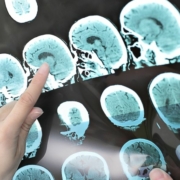Alzheimer’s Treatments: Options and Research
Alzheimer’s disease (AD) is a complex brain disorder that primarily affects people with advanced age. In this article, we dive into Alzheimer’s treatment options. At present, there are nearly six million Americans who have been diagnosed with Alzheimer’s disease, of which the majority are older than age 75. Data reveals that one in nine Americans over the age of 65 has AD. Despite decades of research, no cure for Alzheimer’s Disease has been discovered.

While good progress has been made in understanding the disorder, the ultimate cure for the condition does not exist. All the present-day treatments we have are used to treat symptoms of the disorder, but, unfortunately, these treatments only work during the early stages of the disease, and some can also have serious side effects. Sadly, many AD individuals have to be admitted into long-term care facilities as their management in the home is exceedingly difficult and causes great stress to the caregiver.
As the individual with AD passes through the various stages, different types of symptoms may appear. Today, there are several prescription medications approved by the Food and Drug Administration (FDA) to help manage the symptoms. Just this year, a novel drug called aducanumab was developed, which can reduce the amyloid deposits in the brain and slow the progression of AD. It is not yet known, however, if the drug can prevent dementia or cognitive decline in the long term. For the majority of individuals with AD, the best treatment today is supportive care and preventing harm.
The Symptoms & Treatment
The majority of AD patients will develop memory loss, behavioral changes, mood disorders, and language problems. Without treatment of Alzheimer’s Disease, there is usually a progression of the symptoms which can create havoc in the life of the AD diagnosed individual and everyone around them. Hence, drug treatment is necessary because it can provide the individual with longer independence and comfort. More importantly, the medications make it a more dignified way to live. Finally, the use of medications makes it a little easier for the caregivers to manage these individuals at home.
Treatments for Mild AD
There are currently three available drugs to treat mild AD. These are: Rivastigmine, Galantamine, and Donepezil. All three drugs are classified as cholinesterase inhibitors and require a prescription. These medications for the treatment of Alzheimer’s Disease may decrease the behavioral and cognitive symptoms. How these drugs act is not fully understood and not all individuals with AD respond to them. Because all three drugs work similarly, switching the drugs does not help if the individual is not responding to one medication.
The latest drug to enter Alzheimer’s treatment options is Aducanumab, which is classified as a disease-modifying drug. Aducanumab is an antibody that targets amyloid plaques in the brain; these amyloid plaques have been linked to AD. The drug can only be given via injection and requires admission to the hospital. Clinical trials reveal that the Aducanumab is only effective in patients who have amyloid plaques and can slow down the cognitive impairment, but whether it will work in the long term remains unknown. Before the drug is prescribed, doctors need to obtain a PET scan to determine if amyloid plaques are present in the brain. In addition, the cost of the drug is prohibitive and not covered by most insurers. More clinical trials have been planned to assess the long-term effectiveness of the drug and its potential side effects. Several other similar drugs are also being investigated as potential treatments for early AD.
Treatment of Moderate to Severe Disease
When AD has progressed, most of the individuals will fail to respond to the cholinesterase inhibitors. These individuals may be treated with a drug called Memantine, which can help reduce the symptoms and enable some individuals to perform some daily living activities for a little while longer. For example, the drug may maintain the ability to dress or use the bathroom independently for a few more months, which can be a relief for caregivers. Because Memantine works differently compared to the cholinesterase inhibitor drugs, it can be combined for a more effective response. But, of course, this also increases the risk of developing adverse side effects.
No matter which drug the patient is treated with, the starting dose is usually very low and gradually increased based on the response. In general, individuals with AD tend to respond to higher doses of these drugs, but this also is associated with a high risk of adverse side effects.
Monitoring
During the drug treatment, AD patients need monitoring for side effects, which can include the following:
- Nausea
- Vomiting
- Loss of appetite
- Allergic reactions
- Diarrhea
If these side effects persist, the drug has to be discontinued. To avoid side effects, all caregivers need to follow the healthcare worker’s advice and avoid the use of other medications or supplements without first speaking to the doctor.
Treating the behavior symptoms in AD
The majority of AD individuals will, at some point, develop disrupting behavior symptoms that include the following:
- Wandering
- Insomnia
- Anxiety
- Agitation
- Restlessness
- Aggression
- Paranoia
- Depression
These behavior symptoms often require treatment to ease the stress on the caregivers and make the AD individual more comfortable. But medications are not the first choice of treatment for behavioral symptoms. The first choice is non-drug therapies that include making the environment safe. Drugs are only started when the behavior systems become unmanageable with non-drug therapies.
What medications are used to treat behavioral symptoms?
A wide range of Alzheimer’s treatment options are used to treat the behavioral symptoms in AD and include the following:
- Antipsychotics to control agitation, anger, paranoia
- Sleeping pills to improve sleep
- Anticonvulsants to control behavior when the antipsychotics don’t work
- Antidepressants to manage the depression
It is important to understand that all these medications have potential side effects which can worsen the quality of life and, hence, are only started when there is no other choice. After starting these medications, the patient with AD is closely monitored for side effects. In most cases, the lowest dose of the drug is used, and the treatment is only for short periods.
Supportive and Safe Environment
To ensure that the individual with AD can adapt to the living environment and be safe, here are some non-drug remedies that are highly recommended:
- Ensure that all valuable items that belong to the AD individual are stored safely, like a wallet, keys, etc.
- Keep track of all medications, including the dosages. All medications should be stored in a secure location.
- Ensure that all bills are paid via automatic payments.
- Provide a phone with a tracker so that the individual can be tracked 24/7. The home phone number should be programmed and easily activated with the press of a button.
- All windows and doors in the home should have alarm sensors.
- Try to make all regular appointments with healthcare workers on the same day to prevent frequent disruptions in daily life.
- Use a calendar to track daily schedules.
- Remove all cumbersome rugs and excess furniture to prevent falls and slips.
- Install handrails in the bathrooms and stairway
- Provide non-slip shoes.
- Remove excess mirrors as they can confuse AD individuals.
- Ensure that the AD individual has a medical alert bracelet worn at all times.
- To maintain familiarity, keep photos and other familiar objects in the home.
The Future
Researchers are continually trying to develop new Alzheimer’s treatment options, not only to lessen the symptoms but to also help prevent the progression of the disease. It is important to understand, though, that drug treatment is only one aspect of managing AD patients. These individuals also need cognitive learning, physical activity, and other supportive therapies. Most individuals require more than one treatment. Not to be forgotten, looking after a family member with AD can be very taxing and it is important that the caregiver also closely follow up with a healthcare provider to prevent a mental breakdown.
Even though there is no cure for AD, both drug and non-drug Alzheimer’s treatment options can help ease the symptoms, ensure safety, and improve the quality of life. Caregivers should be aware of support systems available and utilize them to ease personal stress.
Cano Health is at the forefront of innovative new healthcare technology and leads the way toward patient-centered care. Call them today at 1.855.975.5119 to learn how they can be of benefit to you.









